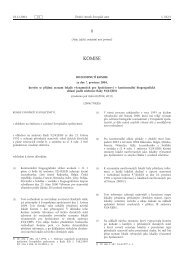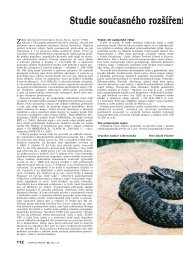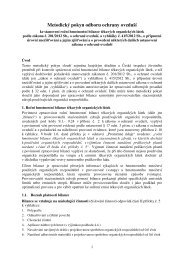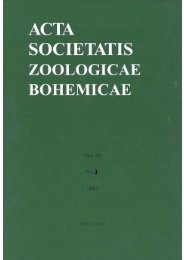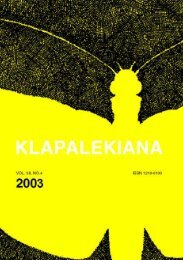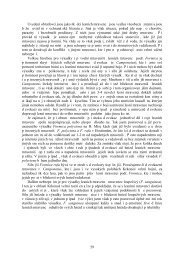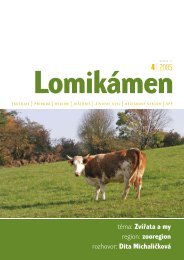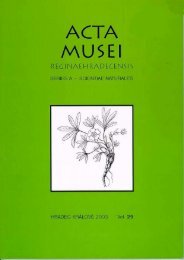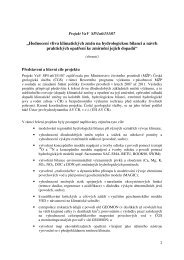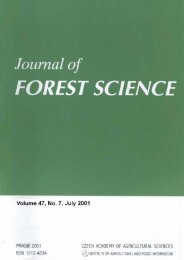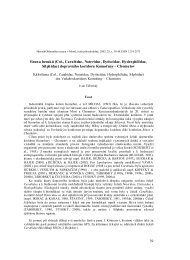Distribution and taxonomy of some Synapsis species, with ...
Distribution and taxonomy of some Synapsis species, with ...
Distribution and taxonomy of some Synapsis species, with ...
Create successful ePaper yourself
Turn your PDF publications into a flip-book with our unique Google optimized e-Paper software.
TYPE MATERIAL EXAMINED. LT male <strong>of</strong> Silpha olivieri aquilana (IEUS; here designated), labelled “ABRUZZI / Cerchio<br />
/ G. Leoni [p] // v. [sic!] aquilana / m. [hw, Depoli’s MS] / G. Depoli det. [p] // LECTOTYPE (male symbol) / Silpha<br />
olivieri / aquilana Depoli, 1931 / Jan R%ži!ka design. 2002 [p, red label] // Silpha / olivieri / Bedel, 1887 / Jan<br />
R%ži!ka det. 2002 [p]”; PLT 2 females (IEUS), labelled “ABRUZZI / Cerchio / G. Leoni [p] // PARALECTO-<br />
TYPE (female symbol) / Silpha olivieri / aquilana Depoli, 1931 / Jan R%ži!ka design. 2002 [p, red label] // Silpha<br />
/ olivieri / Bedel, 1887 / Jan R%ži!ka det. 2002 [p]”; PLT female (IEUS), labelled “Cerchio / Abruzzo [p] //<br />
PARALECTOTYPE (female symbol) / Silpha olivieri / aquilana Depoli, 1931 / Jan R%ži!ka design. 2002 [p, red<br />
label] // Silpha / olivieri / Bedel, 1887 / Jan R%ži!ka det. 2002 [p]”; PLT male (IEUS), labelled “Cerchio / Abruzzo<br />
[hw] // PARALECTOTYPE (male symbol) / Silpha olivieri / aquilana Depoli, 1931 / Jan R%ži!ka design. 2002 [p,<br />
red label] // Silpha / olivieri / Bedel, 1887 / Jan R%ži!ka det. 2002 [p]”.<br />
LT female <strong>of</strong> Silpha olivieri sardoa (IEUS; here designated), labelled “ITALIA [p] / Sardegna [hw] / G. Leoni<br />
[p] // v. [sic!] sardoa / m. [hw, Depoli’s MS] / G. Depoli det. [p] // LECTOTYPE (female symbol) / Silpha olivieri<br />
/ sardoa Depoli, 1931 / Jan R%ži!ka design. 2002 [p, red label] // Silpha / olivieri / Bedel, 1887 / Jan R%ži!ka det.<br />
2002 [p]”; PLT 2 males (IEUS), labelled “ITALIA [p] / Sardegna [hw] / G. Leoni [p] // PARALECTOTYPE (male<br />
symbol) / Silpha olivieri / sardoa Depoli, 1931 / Jan R%ži!ka design. 2002 [p, red label] // Silpha / olivieri / Bedel,<br />
1887 / Jan R%ži!ka det. 2002 [p]”; PLT female (IEUS), labelled “ITALIA [p] / Sardegna / S. Lussurgiu [hw] / G.<br />
Leoni [p] // PARALECTOTYPE (female symbol) / Silpha olivieri / sardoa Depoli, 1931 / Jan R%ži!ka design.<br />
2002 [p, red label] // Silpha / olivieri / Bedel, 1887 / Jan R%ži!ka det. 2002 [p]”.<br />
COMMENTS. Silpha olivieri is a widely distributed Mediterranean <strong>species</strong> (Portevin 1926, Pilo.a et<br />
al. 2002).<br />
Depoli (1931) described Silpha olivieri aquilana based on an unknown number <strong>of</strong> specimens<br />
from Italy: Aquila: Cerchio. His description indicate a smaller <strong>and</strong> more flattened body <strong>and</strong> finer<br />
punctation on elytra in comparison <strong>with</strong> the nominotypical sub<strong>species</strong>. I have studied a series <strong>of</strong><br />
syntype specimens from coll. G. Leoni, the specimen bearing the original Depoli’s determination<br />
label is designated here as a lectotype, the remaining four specimens as paralectotypes. All specimens<br />
are smaller (combined length <strong>of</strong> pronotum <strong>and</strong> elytra is 14–16 mm, 15 mm in the lectotype),<br />
but otherwise similar to specimens from coll. G. Leoni, determined by G. Depoli as S. olivieri.<br />
Depoli (1931) described Silpha olivieri sardoa based on an unknown number <strong>of</strong> specimens<br />
from Italy: Sardinia. His description indicate paler coloration <strong>of</strong> elytra <strong>and</strong> more rugose interstries<br />
<strong>with</strong> more superficial punctation <strong>of</strong> elytra in comparison <strong>with</strong> the nominotypical form. I have<br />
studied a series <strong>of</strong> syntype specimens from coll. G. Leoni, the first specimen bearing the original<br />
Depoli’s determination label is designated here as a lectotype, the remaining three specimens as<br />
paralectotypes. All specimens are black in colour, <strong>with</strong> similar punctation on elytra as specimens<br />
from coll. G. Leoni, determined by G. Depoli as S. olivieri. Three <strong>of</strong> the four specimens examined<br />
have slightly more rugose interstries on elytra (however, the fourth specimen, cited above as the<br />
last one, is similar the to nominotypical form).<br />
In my opinion, all differences mentioned by Depoli (1931) for both sub<strong>species</strong> fall <strong>with</strong>in individual<br />
variation <strong>of</strong> Silpha olivieri. Reitter (1884) commented on the variation in rugosity <strong>and</strong><br />
punctation <strong>of</strong> elytra <strong>with</strong>in the distribution area <strong>of</strong> this <strong>species</strong>. Consequently, I consider Silpha<br />
olivieri aquilana Depoli, 1931 <strong>and</strong> Silpha olivieri sardoa Depoli, 1931 as junior subjective synonyms<br />
<strong>of</strong> Silpha olivieri Bedel, 1887.<br />
Silpha perforata Gebler, 1832<br />
Silpha perforata Gebler, 1832: 49.<br />
Silpha venatoria Harold, 1877: 346; syn. n.<br />
Silpha perforata var. lateralis Portevin, 1926: 70; syn. n.<br />
Silpha perforata m<strong>and</strong>li Portevin, 1932: 48; syn. n.<br />
Silpha perforata elongata Portevin, 1943: 48; syn. n.<br />
TYPE MATERIAL EXAMINED. LT male <strong>of</strong> Silpha venatoria (ZMHB; here designated), labelled “Mohezi / Hilgendorf [leg.]<br />
[hw, yellow label] // 59048 [p] // Type [p, orange label] // venatoria / (star symbol) / Harold [hw, yellow label] //<br />
313



